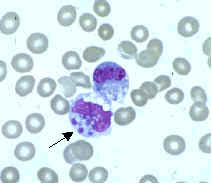Human monocytotropic ehrlichiosis
| Human monocytic ehrlichiosis | |
|---|---|
 | |
| Ehrlichia chaffeensis | |
| Specialty | Infectious diseases |
Human monocytotropic ehrlichiosis
Symptom and signs
The most common symptoms are
The severity of the illness can range from minor or asymptomatic to life-threatening. CNS involvement may occur. A serious septic or toxic shock-like picture can also develop, especially in patients with impaired immunity.[5]
Cause
This disease is known to be caused by tick bites.[6]
Diagnosis
Tick exposure is often overlooked. For patients living in high-prevalence areas who spend time outdoors, a high degree of clinical suspicion should be employed.[citation needed] Ehrlichia serologies can be negative in the acute period. Polymerase chain reaction is therefore the laboratory diagnostic tool of choice.[7]
Treatment
If ehrlichiosis is suspected, treatment should not be delayed while waiting for a definitive laboratory confirmation, as prompt doxycycline therapy has been associated with improved outcomes.[8] Doxycycline is the treatment of choice.[citation needed]
Presentation during early pregnancy can complicate treatment.
Epidemiology
In the US, human monocytotropic ehrlichiosis occurs across the south-central, southeastern, and mid-Atlantic states, regions where both the white-tailed deer (Odocoileus virginianus) and its ectoparasite, Lone Star ticks (Amblyomma americanum), thrive.[11][12][13]
Human monocytotropic ehrlichiosis occurs in California in Ixodes pacificus ticks and in Dermacentor variabilis ticks.[14] Nearly 600 cases were reported to the CDC in 2006. In 2001–2002, the incidence was highest in Missouri, Tennessee, and Oklahoma, as well as in people older than 60.[15]
See also
- Human ewingii ehrlichiosis
- Human granulocytic anaplasmosis
- Monocyte
References
- ISBN 978-1-4160-2999-1.
- S2CID 1191660.
- S2CID 11384349.
- PMID 16485466.
- PMID 11568857.
- ^ "Ehrlichiosis – Transmission". United States Center for Disease Control. 17 January 2019. Retrieved November 23, 2020.
- S2CID 31487400.
- S2CID 2632346.
- PMID 18509484.
- PMID 12949322.
- PMID 34467183.)
{{cite journal}}: CS1 maint: DOI inactive as of November 2024 (link - ^ "Ehrlichiosis: Transmission". Centers for Disease Control and Prevention. 17 January 2019. Retrieved 18 April 2024.
- ^ "Tickborne Diseases of the United States: Ehrlichiosis". Centers for Disease Control and Prevention. 15 December 2023. Retrieved 18 April 2024.
- PMID 14680123.
- ^ "Statistics and Epidemiology: Annual Cases of Ehrlichiosis in the United States". Ehrlichiosis. Division of Vector-Borne Diseases (DVBD), National Center for Emerging and Zoonotic Infectious Diseases (NCEZID), Centers for Disease Control and Prevention. 5 September 2013.
